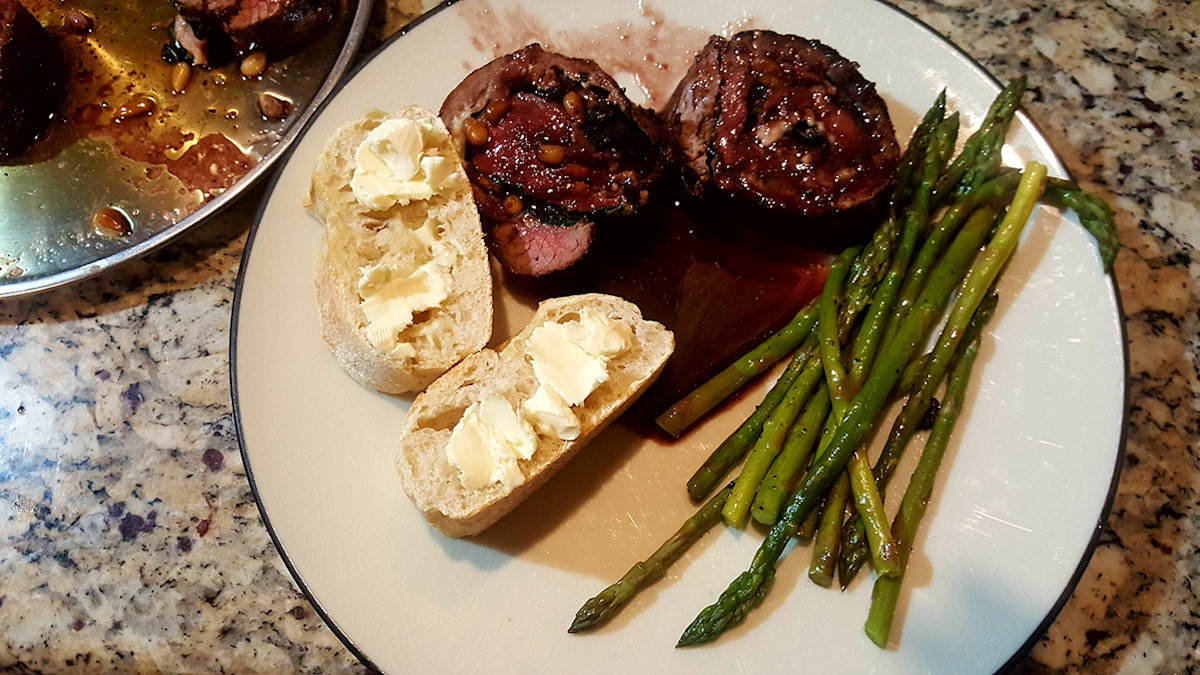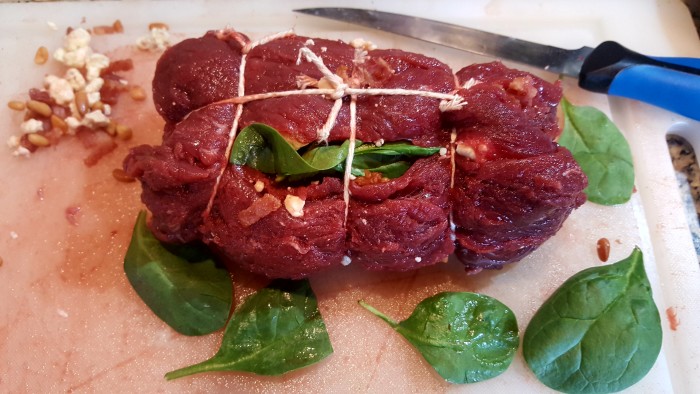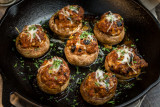
Course
Main
Venison backstrap is a cut of meat that’s held in the highest regard by most big game hunters. Whether this tender, tasty cut comes from whitetails or mountain goats, it is the meat we most often associate with high-quality wild game meals. We’ll hoard it for months just so we can enjoy a chunk of simple, grilled backstrap well after hunting season has ended. But you can only eat backstrap cooked the same old way, time after time, year after year before it starts to lose some of its appeal.
So, I fooled around with different ways to prepare backstrap in order to add a little more versatility to this fine cut of meat. I gave up on grilled, bacon-wrapped backstrap a long time ago but I did figure out a way to retain some of the tastes from that cooking method while also adding new savory flavors and interesting textures. This recipe has been a long-time favorite when I want to make a high-falutin, four-star restaurant type dinner that will leave a lasting impression with friends or family.
Ingredients
- 1 lb venison backstrap loin (one piece)
- ¼ lb cubed prosciutto
- ¼ lb fresh spinach leaves
- ¼ lb bleu or plain goat cheese
- ¼ lb roasted pine nuts
- Salt
- Black pepper
- Steak seasoning
- 2+ tablespoons butter
- Olive oil
- Butcher twine
Sauce
- 1 cup red wine
- 1 cup wild game or chicken stock
- ¼ cup blackberry or blueberry jam
- 2 tbsp. butter
- 1 shallot
- 1 clove garlic
- Dash salt
- Dash black pepper
- Dash cayenne pepper
Preparation
Sauce Whenever I’m cooking any recipe that involves a sauce, I like to do it ahead of time. First, cut your shallot and garlic clove into fine pieces. Now, add the butter to a small saucepan and saute the shallots over medium heat just until they begin soften and brown slightly. Add the garlic and cook for another minute. Now, add your stock,lower the heat and simmer until it is reduced by half. Add the wine, salt, pepper, and cayenne and simmer to incorporate. After a few minutes, you can add the jam and mix it into the sauce. Simmer until the sauce it thicken slightly and sticks to the bottom of a spoon. Strain the sauce with a fine wire mesh strainer and discard cooked shallots and garlic. Keep the strained sauce warm over very low heat or warm just before serving dinner.
Backstrap Begin by sautéeing the cubed prosciutto in an iron skillet or dutch oven until it begins to crisp. Remove from pan and set aside. Toast the pine nuts for a few minutes on a cookie sheet in a 350 degree oven until lightly browned. Remove the nuts from the oven and set aside but leave the oven on.
For the meat, you’ll want to use use about a 10-12 inch section of the thick, round portion of the middle part of backstrap rather than the thin, flat section at the lower end or the narrow top section near the neck. You can go with a shorter piece from a large animal like an elk or moose. Cut this piece lengthwise in a spiral pattern from the outside in until you have a wide, flat, piece of meat about a third of an inch thick. Now, lay out your flat piece backstrap on a cutting board. If necessary, you can pound the backstrap flat with a meat hammer to achieve a uniform thickness. Sprinkle the meat with the prosciutto and roasted pine nuts, then add a layer of crumbled bleu cheese, and finally a layer of crumbled spinach leaves. For folks who don’t like the strong flavor of bleu cheese, use plain goat cheese. This technique is similar to the ballotine method of stuffing and rolling flattened chicken breasts.

Now carefully and tightly roll the whole works back into the original cylindrical shape of a piece of backstrap. Next, you’ll need to secure it with butcher twine so it doesn’t fall apart. Three knotted wraps is usually enough. Coat the whole thing in salt, pepper, steak seasoning, and olive oil.


Get the iron skillet or dutch oven very hot. Now add the butter to the leftover fat from the prosciutto in the iron skillet. Add your backstrap to the skillet and quickly get a good sear on all sides. You want a crusty, dark sear. Spoon the pan drippings over the meat as you sear it. You’ll know it is properly seared if the meat doesn’t stick to the pan.
Once the backstrap is seared, quickly place the skillet in the 350-degree oven (or grill). Check the internal temperature after five minutes. And depending on size and thickness, continue to check it every minute or two until it reaches the ideal internal, temperature of 125 degrees in the center. Do not overcook it. Once it’s reached rare, remove it from the oven immediately and take it out of the skillet to rest for ten minutes. Keep in mind, the meat will continue to cook as it rests.

Slice the stuffed backstrap into pieces about a half an inch thick and drizzle with warm sauce. This recipe is great served with red wine, a green salad or steamed asparagus, and crispy sauteed potatoes or warm, crusty bread. Get out of the old grilled, bacon-wrapped backstrap rut with this trophy meal.
Sign In or Create a Free Account
Reviews
Venison backstrap is a cut of meat that’s held in the highest regard by most big game hunters. Whether this tender, tasty cut comes from whitetails or mountain goats, it is the meat we most often associate with high-quality wild game meals. We’ll hoard it for months just so we can enjoy a chunk of simple, grilled backstrap well after hunting season has ended. But you can only eat backstrap cooked the same old way, time after time, year after year before it starts to lose some of its appeal.
So, I fooled around with different ways to prepare backstrap in order to add a little more versatility to this fine cut of meat. I gave up on grilled, bacon-wrapped backstrap a long time ago but I did figure out a way to retain some of the tastes from that cooking method while also adding new savory flavors and interesting textures. This recipe has been a long-time favorite when I want to make a high-falutin, four-star restaurant type dinner that will leave a lasting impression with friends or family.
Ingredients
- 1 lb venison backstrap loin (one piece)
- ¼ lb cubed prosciutto
- ¼ lb fresh spinach leaves
- ¼ lb bleu or plain goat cheese
- ¼ lb roasted pine nuts
- Salt
- Black pepper
- Steak seasoning
- 2+ tablespoons butter
- Olive oil
- Butcher twine
Sauce
- 1 cup red wine
- 1 cup wild game or chicken stock
- ¼ cup blackberry or blueberry jam
- 2 tbsp. butter
- 1 shallot
- 1 clove garlic
- Dash salt
- Dash black pepper
- Dash cayenne pepper
Preparation
Sauce Whenever I’m cooking any recipe that involves a sauce, I like to do it ahead of time. First, cut your shallot and garlic clove into fine pieces. Now, add the butter to a small saucepan and saute the shallots over medium heat just until they begin soften and brown slightly. Add the garlic and cook for another minute. Now, add your stock,lower the heat and simmer until it is reduced by half. Add the wine, salt, pepper, and cayenne and simmer to incorporate. After a few minutes, you can add the jam and mix it into the sauce. Simmer until the sauce it thicken slightly and sticks to the bottom of a spoon. Strain the sauce with a fine wire mesh strainer and discard cooked shallots and garlic. Keep the strained sauce warm over very low heat or warm just before serving dinner.
Backstrap Begin by sautéeing the cubed prosciutto in an iron skillet or dutch oven until it begins to crisp. Remove from pan and set aside. Toast the pine nuts for a few minutes on a cookie sheet in a 350 degree oven until lightly browned. Remove the nuts from the oven and set aside but leave the oven on.
For the meat, you’ll want to use use about a 10-12 inch section of the thick, round portion of the middle part of backstrap rather than the thin, flat section at the lower end or the narrow top section near the neck. You can go with a shorter piece from a large animal like an elk or moose. Cut this piece lengthwise in a spiral pattern from the outside in until you have a wide, flat, piece of meat about a third of an inch thick. Now, lay out your flat piece backstrap on a cutting board. If necessary, you can pound the backstrap flat with a meat hammer to achieve a uniform thickness. Sprinkle the meat with the prosciutto and roasted pine nuts, then add a layer of crumbled bleu cheese, and finally a layer of crumbled spinach leaves. For folks who don’t like the strong flavor of bleu cheese, use plain goat cheese. This technique is similar to the ballotine method of stuffing and rolling flattened chicken breasts.

Now carefully and tightly roll the whole works back into the original cylindrical shape of a piece of backstrap. Next, you’ll need to secure it with butcher twine so it doesn’t fall apart. Three knotted wraps is usually enough. Coat the whole thing in salt, pepper, steak seasoning, and olive oil.


Get the iron skillet or dutch oven very hot. Now add the butter to the leftover fat from the prosciutto in the iron skillet. Add your backstrap to the skillet and quickly get a good sear on all sides. You want a crusty, dark sear. Spoon the pan drippings over the meat as you sear it. You’ll know it is properly seared if the meat doesn’t stick to the pan.
Once the backstrap is seared, quickly place the skillet in the 350-degree oven (or grill). Check the internal temperature after five minutes. And depending on size and thickness, continue to check it every minute or two until it reaches the ideal internal, temperature of 125 degrees in the center. Do not overcook it. Once it’s reached rare, remove it from the oven immediately and take it out of the skillet to rest for ten minutes. Keep in mind, the meat will continue to cook as it rests.

Slice the stuffed backstrap into pieces about a half an inch thick and drizzle with warm sauce. This recipe is great served with red wine, a green salad or steamed asparagus, and crispy sauteed potatoes or warm, crusty bread. Get out of the old grilled, bacon-wrapped backstrap rut with this trophy meal.







